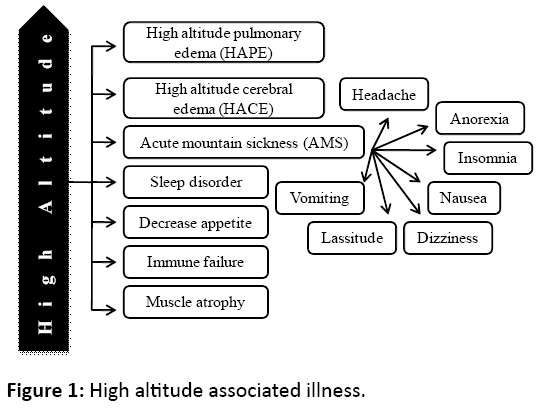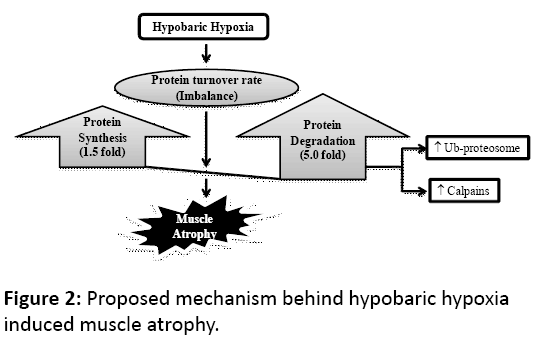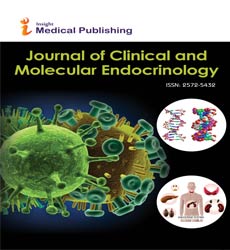Muscle Atrophy at High Altitude
Richa Rathor and Geetha Suryakumar
Richa Rathor* and Geetha Suryakumar
Cellular Biochemistry Division, Defence Institute of Physiology and Allied Sciences, Lucknow Road, Timarpur
- *Corresponding Author:
- Rathor R
Cellular Biochemistry Division
Defence Institute of Physiology and Allied Sciences
Lucknow Road, Timarpur
Tel: 09-11-123883311
Fax: 091-11-23914790
E-mail: richa110in@gmail.com
Received date: August 08, 2016; Accepted date: August 23, 2016; Published date: August 26, 2016
Citation: Rathor R, Suryakumar G (2016) Muscle Atrophy at High Altitude. J Clin Mol Endocrinol 1:18. doi: 10.21767/2572-5432.100016
Copyright: © 2016 Rathor R, et al. This is an open access article distributed under the terms of the Creative Commons Attribution License, which permits unrestricted use, distribution, and reproduction in any medium, provided the original author and source are credited.
Abstract
Stress described as uncomfortable condition which can affect at any age and gender. One of the environmental stresses encounter by people ascending at high altitude is hypobaric hypoxia. High altitude associated hypobaric hypoxia disturbs various physiological and metabolic systems in the body in which one of the adverse effects is muscle atrophy. Hence, the present mini review presents an insight for mechanism involved in muscle protein loss and understanding of these pathways further provide the probable therapeutic interventions against high altitude associated muscle atrophy.
https://transplanthair.istanbul
https://hairclinicturkey.co
https://hairclinicistanbul.co
https://besthairtransplant.co
https://hairtransplantistanbul.co
Keywords
High altitude; Hypoxia; Muscle atrophy
Introduction
Stress is described as any uncomfortable condition which affect people of all ages and genders which ultimately lead to physical and psychological health issues. Specific definition of stress describes “emotional experience accompanied by predictable biochemical, physiological and behavioral changes.” [1]. Some stress provide positive energy to the individual like exam stress and work deadlines stress. On the other hand, some extreme stress provide negative energy to the person which lead to health issues like immune, cardiovascular, neuroendocrine and central nervous systems [2].
High altitude is defined as an altitude exceeding 2400 m above sea level. More than 140 million people reside in these regions which represents ∼2% of the world population. Beside this, our armed forces are also regularly deployed at high altitude due to military and strategic reasons. High altitude associated adverse conditions include hypoxia, cold, wind, humidity, harmful ionizing radiations which contribute to various health maladies like high altitude associated pulmonary edema (HAPE), high altitude associated cerebral edema (HACE), acute mountain sickness (AMS), sleep disorder, immune failure, decrease appetite, muscle loss etc. [3-5] (Figure 1).
The overview of high altitude associated problems represents numerous adverse health effects in which one of the major issues is physical performance. The decrease physical performance basically related to muscle fatigue, the major issue on which our lab is engaged. We are making effort to get to know about the cause and the probable intervention to overcome with this issue. A number of reports concluded reduced muscle mass and performance due to high altitude associated hypoxia [6-8].
Our previous findings made contribution in these result as elevated protein turn over rate is contributory for muscle loss due to hypobaric hypoxia exposure [9]. Muscle protein turnover rate is decided by two factors: protein synthesis and protein degradation. Our previous findings described a decline in physical performance by more than 20%, observed in rats by time taken to exhaustion on treadmill following chronic hypobaric hypoxia.
Once, the comparison was made in protein synthesis and degradation rate, it was found that protein synthesis was 1.5 fold higher while protein degradation was 5.0 fold higher (fivefold) during chronic hypobaric hypoxia. Further, protein degradation pathway related pathways were studied in which ubiquitin-proteosome pathway (Ub-proteosome) and calpain pathways were found major culprit for protein degradation in chronic hypobaric hypoxia conditions [10] (Figure 2).
An understanding of the muscle protein degradation pathways could further provide an insight to generate therapeutic implications/strategies for hypobaric hypoxia associated muscle loss. The previous studies related to skeletal muscle atrophy suggests a number of potential therapeutic approaches in which some of them could be tried. Since Ubproteosome and calpains were found one of the major culprits for chronic hypobaric hypoxia associated muscle atrophy, hence, the inhibition of these pathways could provide some beneficial role against muscle loss. In addition, few pharmaceutical/herbal therapeutics which enhance protein synthesis pathway could also able to prevent muscle atrophy during hypobaric hypoxia exposure. Herbals which could provide antioxidant property could also make positive contribution during hypobaric hypoxia exposure. In conclusion, the present review provides an insight for muscle protein loss and the probable therapeutic interventions with consideration to high altitude associated hypoxia condition.
References
- Baum A (1990) Stress, intrusive imagery, and chronic distress. Health Psychol 9: 653-675
- Anderson NB (1998) Levels of analysis in health science. A framework for integrating sociobehavioral and biomedical research. Ann N Y AcadSci 840: 563-576.
- Askew EW (1997) Nutrition and performance in hot, cold, and high altitude environments. In:Wolinsky I (ed.) Nutrition in Exercise and Sport(3rd edn.). CRC Press, Boca Raton. pp. 597–619.
- Paralikar SJ (2012) High altitude pulmonary edema-clinical features, pathophysiology, prevention and treatment. Ind J Occup Environ Med 16: 59–62.
- Hackett PH, Roach RC (2004) High altitude cerebral edema. High Alt Med Biol 5: 136-146.
- Mathieu-Costello O (2001) Muscle adaptation to altitude: tissue capillarity and capacity for aerobic metabolism. High Alt Med Biol 2: 413-425.
- Edwards LM, Murray AJ, Tyler DJ, Kemp GJ, Holloway CJ, et al. (2010) The effect of high-altitude on human skeletal muscle energetics: P-MRS results from the audwellXtreme Everest expedition. PLoS One 5: e10681.
- Calbet JA, Robach P, Lundby C (2009) The exercising heart at altitude. Cell Mol Life Sci 66: 3601-3613.
- Chaudhury P, Suryakumar G, Prasad R, Singh SM, Ali S (2012a) Effect of acute hypobaric hypoxia on skeletal muscle protein turnover. Al Ameen J Med Sci 5:355-361.
- Chaudhary P, Geetha S, Prasad R, Singh SN, Ali S (2012b) Chronic hypobaric hypoxia mediated skeletal muscle atrophy:role of ubiquitin–proteasome pathway and calpains. Mol Cell Biochem 364:101–113.
Open Access Journals
- Aquaculture & Veterinary Science
- Chemistry & Chemical Sciences
- Clinical Sciences
- Engineering
- General Science
- Genetics & Molecular Biology
- Health Care & Nursing
- Immunology & Microbiology
- Materials Science
- Mathematics & Physics
- Medical Sciences
- Neurology & Psychiatry
- Oncology & Cancer Science
- Pharmaceutical Sciences


